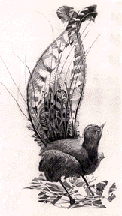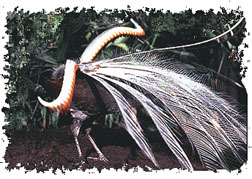The Australasian area is the home of three distinctive families of the great perching bird group. Sharp-billed, short tailed birds with names like the Rifleman (Acanthisitta chloris) and bushwrens form the Acanthisittidae, and two rare scrub-birds, small brown birds with little power of flight and great singing ability, make up the Atrichornithidae.
 Related to the scrub-birds are the spectacular lyrebirds, the two species of which are confined to eastern Australia. Lyrebirds are classed as an independent suborder (Menurae) and family (Menuridae) consisting of two species. The Superb Lyrebird (Menura superba) is chicken-sized and rather nondescript, but males have a unique tail containing three types of feathers, which in certain positions resembles a lyre. The outermost feathers are broad and curled, enclosing a dozen filamentous, gauze-like feathers and two very long, tapered, and curled plumes totaling 16 feathers. Females have a long tail, but they barely show signs of the developments found in males. Lyrebirds feed on insects, myriapods and snails.
Related to the scrub-birds are the spectacular lyrebirds, the two species of which are confined to eastern Australia. Lyrebirds are classed as an independent suborder (Menurae) and family (Menuridae) consisting of two species. The Superb Lyrebird (Menura superba) is chicken-sized and rather nondescript, but males have a unique tail containing three types of feathers, which in certain positions resembles a lyre. The outermost feathers are broad and curled, enclosing a dozen filamentous, gauze-like feathers and two very long, tapered, and curled plumes totaling 16 feathers. Females have a long tail, but they barely show signs of the developments found in males. Lyrebirds feed on insects, myriapods and snails.
In the breeding season the male builds a moundlike display area on the forest floor. Here he displays, first singing  elaborate songs, which contain mimicked songs of other birds, mammals, and even mechanical sounds as the horn of a railway locomotive or the honking of an automobile horn; he then spreads his tail over his body. From the front this looks like a silvery 5-foot-wide veil. The female is attracted to breed, and more than one mates with a single male. Each female then goes off to build its domed nest on or near the ground with closely woven roots and fibres and lined with feathers. She gets no help from the male. She lays a single purplish-grey egg blotched with purplish-brown, incubates it, and tends the young.
elaborate songs, which contain mimicked songs of other birds, mammals, and even mechanical sounds as the horn of a railway locomotive or the honking of an automobile horn; he then spreads his tail over his body. From the front this looks like a silvery 5-foot-wide veil. The female is attracted to breed, and more than one mates with a single male. Each female then goes off to build its domed nest on or near the ground with closely woven roots and fibres and lined with feathers. She gets no help from the male. She lays a single purplish-grey egg blotched with purplish-brown, incubates it, and tends the young.
Class: Aves | Order: Passeriformes | Family: Menuridae | Genus: Menura






